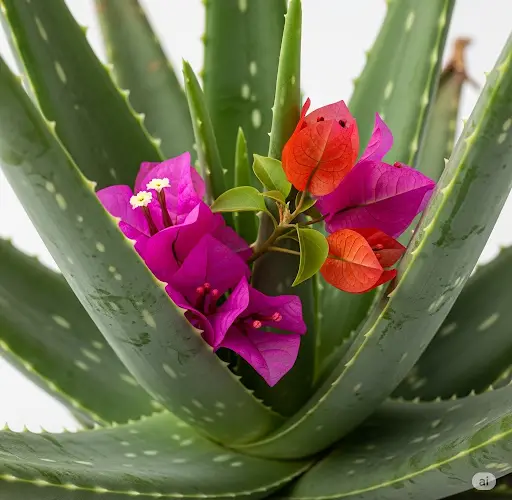Bougainvillea is one of the most vibrant and resilient ornamental plants, known for its brilliant, paper-like blooms and ability to thrive in warm climates. If you’ve ever wanted to multiply your bougainvillea plants without spending money on new ones, propagation through cuttings is the perfect solution. Even better, using aloe vera as a natural rooting medium can boost your success rate while keeping the process 100% chemical-free.
This method combines nature’s best tools—healthy plant cuttings and aloe vera gel—to stimulate root development while protecting the plant from infections and environmental stress. Let’s explore how to grow bougainvillea from cuttings using aloe vera in a simple, sustainable way.
Why Use Aloe Vera for Bougainvillea Cuttings?
Aloe vera is well known for its healing properties in skincare, but it also works wonders in gardening. The gel inside the leaves contains growth-promoting hormones, essential nutrients, and antimicrobial agents. When applied to plant cuttings, aloe vera supports faster and healthier root development while protecting the stem from bacterial or fungal infections.
Key benefits include:
-
Stimulates root growth naturally
-
Protects cuttings from rot, mold, and pathogens
-
Hydrates the cutting during initial rooting phase
-
Increases propagation success without chemical rooting hormones
These properties make aloe vera an ideal companion for propagating woody plants like bougainvillea.
What You’ll Need
To get started, gather the following materials:
-
A healthy bougainvillea branch for cuttings
-
A mature aloe vera leaf (or pure organic aloe vera gel)
-
Pruning shears or a sharp knife
-
Small pots or containers
-
Well-draining potting mix (garden soil mixed with sand or perlite)
-
A plastic bag or bottle (to create a greenhouse effect)
Step-by-Step: How to Root Bougainvillea Cuttings in Aloe Vera
Step 1: Select and Prepare the Cutting
Choose a semi-hardwood stem from a healthy bougainvillea plant. The cutting should be 6 to 8 inches (15–20 cm) long with at least 3 nodes. Remove all flowers and most leaves, leaving only a couple at the top to minimize moisture loss.
Step 2: Prepare the Aloe Vera Gel
Cut a thick aloe vera leaf near the base of the plant. Slice it open lengthwise and extract the gel using a spoon. If using store-bought aloe vera, ensure it is free of additives or preservatives.
Step 3: Treat the Cutting with Aloe Vera
Dip the cut end of the bougainvillea stem into the aloe vera gel, coating it thoroughly. You can also insert the stem directly into a piece of fresh aloe leaf, which serves as a natural rooting chamber.
Step 4: Plant the Cutting
Fill a small pot with a well-draining potting mix. Use a stick or your finger to create a planting hole. Gently insert the aloe-treated cutting into the soil and press the mix around the base to hold it firmly.
Step 5: Create a Humid Microclimate
Cover the pot with a clear plastic bag or a plastic bottle with the bottom removed to maintain humidity and warmth. This mimics a greenhouse and supports early root development.
Step 6: Place in a Bright but Shaded Area
Set the pot in a location with indirect sunlight. Avoid direct exposure in the first few weeks, as too much heat can stress the cutting. Keep the soil lightly moist but not soggy.
Step 7: Monitor and Transplant
After 3 to 4 weeks, check for root growth by gently tugging on the stem. If you feel resistance, roots have formed. Remove the plastic cover and slowly acclimate the new plant to open air. Once it’s stronger, transplant it into a larger container or your garden.
Tips for Better Results
-
Use clean, sterilized tools to prevent disease transmission.
-
Take cuttings in the early morning or late afternoon when plants are less stressed.
-
Avoid overwatering—bougainvillea prefers slightly dry conditions.
-
You can dip the cutting in a cinnamon powder after aloe application for added antifungal benefits.
-
Try multiple cuttings at once to increase your propagation success.
Ideal Season for Propagation
The best time to propagate bougainvillea is during the warmer months—spring or early summer—when the plant is in its active growing phase. This gives the cutting ample time to establish roots before cooler temperatures set in.
Common Mistakes to Avoid
-
Overwatering: Bougainvillea is drought-tolerant; too much moisture can lead to rot.
-
Planting in poor soil: Use light, well-draining soil to prevent root suffocation.
-
Using fully woody stems: Older, hardened wood has a lower success rate than young, flexible stems.
Final Thoughts
Growing bougainvillea from cuttings doesn’t require synthetic hormones or complicated tools. By using aloe vera, you harness the power of nature to nurture new roots, protect the plant, and promote healthy growth. This natural method is easy, effective, and sustainable—making it an excellent choice for gardeners of all skill levels.
Try this technique the next time you want to expand your garden. With a bit of care and patience, you’ll soon be rewarded with new bougainvillea plants blooming in vibrant colors—all from a simple cutting and an aloe vera leaf.



